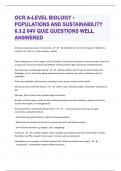Animals and plants present in Antarctica - ✔ ✔ All endothermic rely on thick layers of blubber to
insulate from cold, e.g. seals, penguins, whales.
Plants only grow in ice-free regions (2% of content). Lichens and moss grow in any favourable niche such
as sand, soil, rock and on bones and feathers of dead animals. Algae also grow in sheltered areas.
Animals present at Galapagos Islands - ✔ ✔ Mostly reptiles, which only one land mammal, the
Galapagos rice rat. Arrived by being washed away from mainland river banks, floating on rafts of
vegetation.
They have adapted to environment, resulting in many species unique to the islands.
Animals present at the lake distract - ✔ ✔ Water voles, natterjack toads, and number of species of
bat.
Red deer, birds of prey such as golden eagle and osprey.
Number of native species under threat including red squirrel and the vendace, a species of fish only
found in this region, on endangered list.
Animals present in Snowdonia National Park - ✔ ✔ - coast and estuary birds eg. choughs,
cormorants, and oystercatchers.
- forest birds eg. pied flycatcher, redstart and wood warblers
- Moorland and mountain birds such as ospreys, buzzards, and sparrow hawks
- over 40 land mammals e.g. badgers, deer, hedgehogs.
Antarctica - ✔ ✔ Coldest, highest, driest, windiest and emptiest continent. Covered by ice sheet,
2km thick, has 70% of world's fresh water. Only has summer and winter.
Competition is an example of a biotic limiting factor. What are the two main types? - ✔ ✔
Interspecific - competition between different species.
, Intraspecific competition - competition between members of same species.
Control of human activities at Lake District - ✔ ✔ Like Snowdonia, to conserve region while enabling
access for many millions of visitors each year.
Active management of countryside, for example, through replanting native tree species, this fragile
ecosystem is being secured for generations to come.
Cultivation in the Masai Mara - ✔ ✔ Increased, as grassland converted into cropland, natural
vegetation removed, nutrients in soil used up, leading to reliance on fertilisers for effective crop growth.
Ecosystem of peat bogs - ✔ ✔ Formed with plant material inhibited from fully decaying, occurs in
wet or bogy areas, and composed of mosses, sedges and shrubs.
Plants that grow on bogs adapted to grow and thrive in wet conditions with few nutrients. Bogs support
insects.
Lack of predators and human disturbance makes ideal for birds to nest there.
Abundance of insects, spiders and frogs, plus nutritious vegetation and berries provides food. Ideal
hunting grounds for birds.
Ecosystem of the Masai Mara - ✔ ✔ Savannah ecosystem, divided by main Mara river. Fertile regions
close to river are rich grasslands and woodland, further from river are plains with scattered shrubs and
trues. Has annual zebra and wildebeest migrations, is home to buffalos, elephants, leopards, lions and
black rhinos.
In past was dominated by acacia bush, providing habitat for tsetse fly which is carrier of African
trypanosomiasis disease. To reduce disease, cleared major tracts of acacia. Cattle, elephant, and fire also
reduced presence of it.
Ecosystem of the Terai region of Nepal - ✔ ✔ Region hot and humid in summer, is composed of
fertile alluvial soil which is rich in plant nutrients , has extreme biodiversity.
Important source of national income.
Removal of large parts of forest exacerbated the effect of monsoon flood, causing severe disruption to
communities downstream, if continues only small packets of forests will be lost, and population rely on
income from forests.
Ecotourism in the Masai Mara - ✔ ✔ Relies on tourism for economic input.




